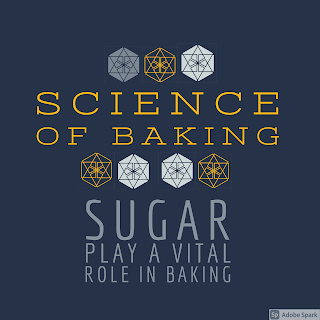Science in Sugar: play a vital role in Baking!
Sugar is made from the leaves of the sugarcane plants through photosynthesis and stored as a sweet juice in sugarcane stalk. Sugarcane is cut down and harvest then sent to a factory and extracted, purified, filtered and crystallized into golden raw sugar. (finecooking.com)
Sugar is a natural ingredient that has been part of our diet. It is also one of the worlds oldest documented commodities. It is widely believe that cane sugar was first use by man in Polynesia where it spread in India. When the Arab peoples in the seventh century AD invaded persia in 642 AD they found sugar cane being grown and learnt how was it made. Sugar was only Discover by Western Europeans as a result of Crusades in the 11th Century AD and the first sugar was recorded in England in 1069. At this time sugar considered as a" Luxury" (makingsenseofsugar.com)
TYPES OF SUGAR
Sucrose glucose and fructose found in plant.
Galactose found in milk and dairy product
Glucose found in vegetables
Lactose found in milk
Maltose found in barley
Xylose found in wood or straw
Fructose found in Honey and fruit
COMMON TYPES OF SUGAR IN BAKING
Granulated Sugar
Caster sugar (superfine sugar)
Powdered Sugar
Brown Sugar
Coconut sugar
Molasses
Honey
Maple Syrup
SUGAR PLAY A VITAL ROLE IN BAKING
Sugar provides structure - structure of your baking product is determined by a chemical reaction between protein and starches. During the mixing process sugar bonds with water, taking moisture away from the other starches and protein present and limiting gluten development. When you mix your Ingredient flour proteins are hydrated and form a gluten strands. This highly elastic gluten strands from thousand of small bubbles trapping the gases produce during leavening. When your dough or batter put in oven , the bubbles expand and stretch, allowing the dough to rise. By slowing gluten development , sugar helps you give a final product a tender texture and good volume. When your recipe has a proper balance of gluten, starch and sugar. It will have the right height and texture. Too much sugar could end up with droopy texture. If you use a little sugar then too much gluten will develop leaving you with dense texture.
Sugar creates texture- sugar easily binds with water, which accomplish two main things. 1. It locks moisture, keeping your baked goods from drying out. 2. Inhibits gluten development which kepp your cookies, cakes and sweet breads softer. Variances of sugar will create different outcomes. A brown sugar will lend more moisture than white sugar because of the presence of molasses. Sugar also creates crunch on baked goods. In the oven moisture evaporates from the surface of the treats. which allows the exterior sugars to crystallized and brown.
Sugar Facilitates Leavening- sugar makes yeast more effective by providing nourishment for its growth. When yeast break down sugar, it speed up the release of carbon dioxide gas. When these bubbles expand the dough rises faster and more consistent rate.
Sugar add Color- baked good can get their golden brown at sugar at about 170c sugar starts to caramelize turning warm amber color. During baking sugar, amino acids, peptides and proteins go through the process of Maillard Reaction. These reaction result in browning and produce wonderful smell associated with baked goods. The higher the sugar content the darker the golden brown surfae appears. This brown surface help retains moisture and prolong freshness.
Sugar Incorporates Air- when sugar and butter cream together, the sugar crystal rub against the fat causing air pockets. When leavening agents are added. These air pockets goes larger. During baking these air cell expands causing your baked goods to rise. The length time you cream your sugar and fat determines the total amount of air mixture
Sugar stabilizes- sugar serves as whipping aid to stabilize beaten egg foams. In foam type cakes, sugar interacts with egg protein to stabilize the whipped foam structure. In doing so, sugar makes the egg foam more elastic so that air cells can expand and take up gases from the leavening agent. beaten eggs or a meringue hold air bubbles because the mechanical action of the beaters partially coagulates the egg protein. When sugar is added, often with another stabilizer such as salt and cream of tartar, the protein film becomes more adhesive and its ability to hold air bubbles is increased. this results in a stiffer, higher more stable foam.
Sugar gel and preserves- sugar is essential in the gelling process of jams, preserves and jellies, providing consistency and firmness. This gel foaming process called gelation the fruit juices are enmeshed in a network of fibers. Pectin a natural component of fruits can only form a gel when combine with sugar and acid. Sugar is essential because it attracts and hold water during the gelling process. Sugar also serve as preservatives, this is accomplished through osmosis the process whereby water will flow from a weaker solution to a more concreted solution when they are separated by a permeable membrane. In the case of jellies and preserves, the water is withdrawn from these microorganism toward the concentrated sugar syrup. The microorganism dehydrated and incapacitated and are unable to multiply and bring about food to spoilage. (source imperialsugar.com)



Comments
Post a Comment